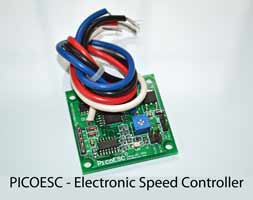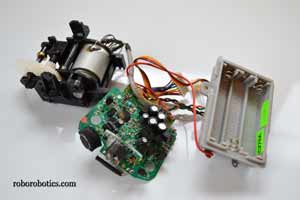DC Motors for Robotics
Using DC motors is one of the best ways to build a drivetrain for a robot. There are some factors to consider when selecting a DC motor and some things that need to be done with the DC motor to work properly with a robot.
DC motors are used by many robot creators and in many robot kits. There are several good reasons DC motors are so popular in robotics including cost, size, availability, easy to program, and DC motors rotate 360 degrees. The main aspect of DC motors which may steer robots makers away from them is they are difficult to control precisely compared to servo motors.
Control of DC Motors
These types of motors are the easiest to control on a macro level, however, precision control can be very difficult to achieve. In most cases, DC motors are considered analog not digital. Generally the way to control a DC motor is by supplying a voltage to the motor. The speed of the motor can be changed by varying the voltage supplied. There are several ways to vary the voltage to the motor. The easiest, but worst way to do so is using a potentiometer. They are available at any electronics store and are cheap. The problem with using a potentiometer is the huge amount of energy that is wasted as heat through this type of transistor. In a robot battery life is critical, so wasted energy is not acceptable.  The best way to vary the voltage is by using an electronic speed controller (ESC). Electronic speed controllers can change the direction of the DC motor and vary its speed. An ESC uses H-bridge circuitry to change the direction the motor shaft travels. Most ESC's are designed specifically for brushless motors. There are some electronic speed controllers that allow use with a brushed DC motor in an open loop mode.
The best way to vary the voltage is by using an electronic speed controller (ESC). Electronic speed controllers can change the direction of the DC motor and vary its speed. An ESC uses H-bridge circuitry to change the direction the motor shaft travels. Most ESC's are designed specifically for brushless motors. There are some electronic speed controllers that allow use with a brushed DC motor in an open loop mode.
DC Motor Speed
Robots cannot be ran directly off of a stock DC motor unless it is a specialty motor that operates a very low speeds. Stock motors run at a speeds of 4000 to 8000 rev./min. This is way too fast to operate a robot. For robotics, the range of motor speed will typically be between 50 to 150 rev./min. The way to slow the speed down is by using gear reductions. Gearboxes, design specifically for robots, are available from several manufacturers including the most popular company Tamiya. Geared motors can also be found that operate under 150 rev./min. There are also gearboxes that can salvaged from old VCRs, printers, and cassette mechanisms. The manufacturer's of these older electronics also had the same challenge of slowing down the speed of a DC motor.
DC Motor Torque
When it comes to DC motor use with robotics, knowing the torque of the motor helps to understand how the motor will operate when it is under a load. The common measurement of torque is typically ft-lb or for smaller motors, oz-in. Torque is a moment which is calculated by multiplying the length of the lever by the force at the end of the lever. The most important thing when considering the torque of a motor is that the speed of the motor is not slowed significantly when the normal operation of loading is added. Look at the manufacturer's running torque rating (if available) for the DC motor. If the motor does slow significantly it will only be a matter of time until it overheats resulting in a failure.
Sources for DC Motors
 Robot suppliers and motor suppliers are a great source for DC motors. There are also many ways to salvage DC motors from different electronics. Some of the best motors come from old printers and copy machines. These items offer a treasure of electronics parts, including DC motors. Kids toys are another place to find DC motors. Goodwill and garage sales are a good place to find toys that have several geared motors, battery holders, and other cool electronic parts.
Robot suppliers and motor suppliers are a great source for DC motors. There are also many ways to salvage DC motors from different electronics. Some of the best motors come from old printers and copy machines. These items offer a treasure of electronics parts, including DC motors. Kids toys are another place to find DC motors. Goodwill and garage sales are a good place to find toys that have several geared motors, battery holders, and other cool electronic parts.
